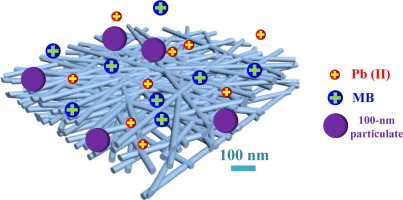Separation and Purification Technology ( IF 8.1 ) Pub Date : 2020-03-03 , DOI: 10.1016/j.seppur.2020.116794 Xing Yin , Zhaoju Zhang , Hongyang Ma , Shyam Venkateswaran , Benjamin S. Hsiao

|
Electrospun sulfonated polyethersulfone (SPES) nanofibrous membranes with ultra-fine mean fiber diameter, e.g., 62 ± 16 nm, were fabricated by a two-nozzle electrospinning approach and employed as a multi-functional membrane for removal of nanoparticles, dyes, and heavy metal ions from multicomponent wastewater through filtration and adsorption, simultaneously. The pore size and pore size distribution of the membrane could be varied and adjusted by controlling the fiber diameter, which affects the filtration retention of nanoparticles while the sulfonic groups located on the surface of the nanofibers work as active sites for the adsorption of dyes and heavy metal ions by electrostatic interaction. Increase in the degree of sulfonation and decrease in the concentration of solution led to the reduction of fiber diameter of the electrospun nanofibrous membranes, as evidenced by SEM and TEM measurements, in addition to the increase in the molecular weight of SPES. The adsorption kinetics and thermodynamics of the nanofibrous membrane for cationic dye and heavy metal ions were investigated, separately, in addition to the filtration performance of nanoparticle suspensions. The ultra-fine nanofibrous SPES membrane was finally tested, with simulated multicomponent wastewater containing 0.2 μm-particles, methylene blue (MB), and Pb (II) ions. The membrane exhibited high permeation flux of 320 L/m2h, high retention of > 99.0 % against nanoparticles, MB and Pb (II), as well as high treated capacity in the filtration performance. The nanofibrous SPES membranes after adsorption of MB and Pb (II) were able to be recovered which indicated the sustainable nature of the membrane for real wastewater treatment.
中文翻译:

用于多组分废水处理的超细电纺纳米纤维膜:过滤和吸附
通过两喷嘴电纺丝方法制造了具有超细平均纤维直径(例如62±16 nm)的电纺磺化聚醚砜(SPES)纳米纤维膜,并用作去除纳米颗粒,染料和重金属的多功能膜多组分废水中的离子通过过滤和吸附同时进行。可以通过控制纤维直径来改变和调节膜的孔径和孔径分布,这会影响纳米颗粒的过滤保持力,而位于纳米纤维表面的磺酸基团则是吸附染料和重金属的活性位点金属离子通过静电相互作用。磺化程度的增加和溶液浓度的降低,除了增加SPES的分子量外,还通过SEM和TEM测量证明了电纺纳米纤维膜的纤维直径减小。除了对纳米颗粒悬浮液的过滤性能外,还分别研究了纳米纤维膜对阳离子染料和重金属离子的吸附动力学和热力学。最后,对超细纳米纤维SPES膜进行了测试,使用了包含0.2μm颗粒,亚甲基蓝(MB)和Pb(II)离子的模拟多组分废水。膜表现出320 L / m的高渗透通量 除了对纳米颗粒悬浮液的过滤性能外,还分别研究了纳米纤维膜对阳离子染料和重金属离子的吸附动力学和热力学。最后,对超细纳米纤维SPES膜进行了测试,使用了包含0.2μm颗粒,亚甲基蓝(MB)和Pb(II)离子的模拟多组分废水。膜表现出320 L / m的高渗透通量 除了对纳米颗粒悬浮液的过滤性能外,还分别研究了纳米纤维膜对阳离子染料和重金属离子的吸附动力学和热力学。最后,对超细纳米纤维SPES膜进行了测试,使用了包含0.2μm颗粒,亚甲基蓝(MB)和Pb(II)离子的模拟多组分废水。膜表现出320 L / m的高渗透通量2小时后,对纳米颗粒,MB和Pb(II)的保留率高> 99.0%,并且在过滤性能方面具有较高的处理能力。吸附了MB和Pb(II)后的纳米纤维SPES膜得以回收,这表明该膜对于实际废水处理具有可持续性。











































 京公网安备 11010802027423号
京公网安备 11010802027423号